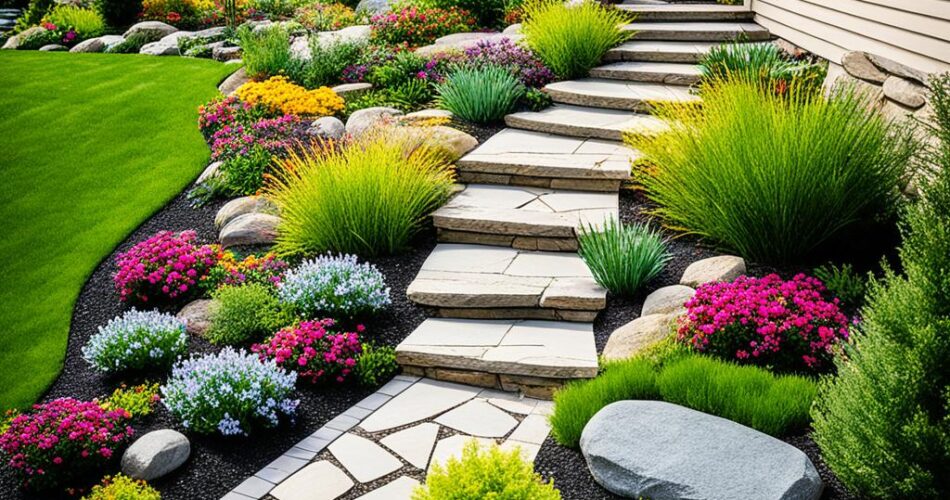Making a small front yard stunning and easy to take care of is simpler than you think. The key is to use the right greenery and smart design choices. By adding beautiful plants in containers and using modern paths and walls, you’ll boost the look of your home. Plus, you’ll create a nice place outside.
Use special plants that don’t need much water, windy paths, and pretty decorations to show off your little front area. Even a small spot can turn into a welcoming space. This space can be perfect for sitting or enjoying a small garden, no matter how tiny it is.
Key Takeaways
- Vertical gardens and tiered planters maximize limited space.
- Low-maintenance native plants enhance curb appeal effortlessly.
- Hardscaping with gravel or pavers defines zones and pathways.
- Symmetrical plantings and hedges create an elegant aesthetic.
- Incorporate seating and decorative accents for an inviting ambiance.
Understanding Small Front Yard Landscaping
Small front yard landscaping is about arranging plants and design elements to make a nice outdoor area. Even in a small space, you can create an inviting outdoor living space. This will make your home look better.
What is Small Front Yard Landscaping?
In the art of small front yard landscaping, you work with a space that is tight. You use smart ways to garden like vertical and container gardening. The main idea is to mix practicality with beauty effectively, using every spot wisely.
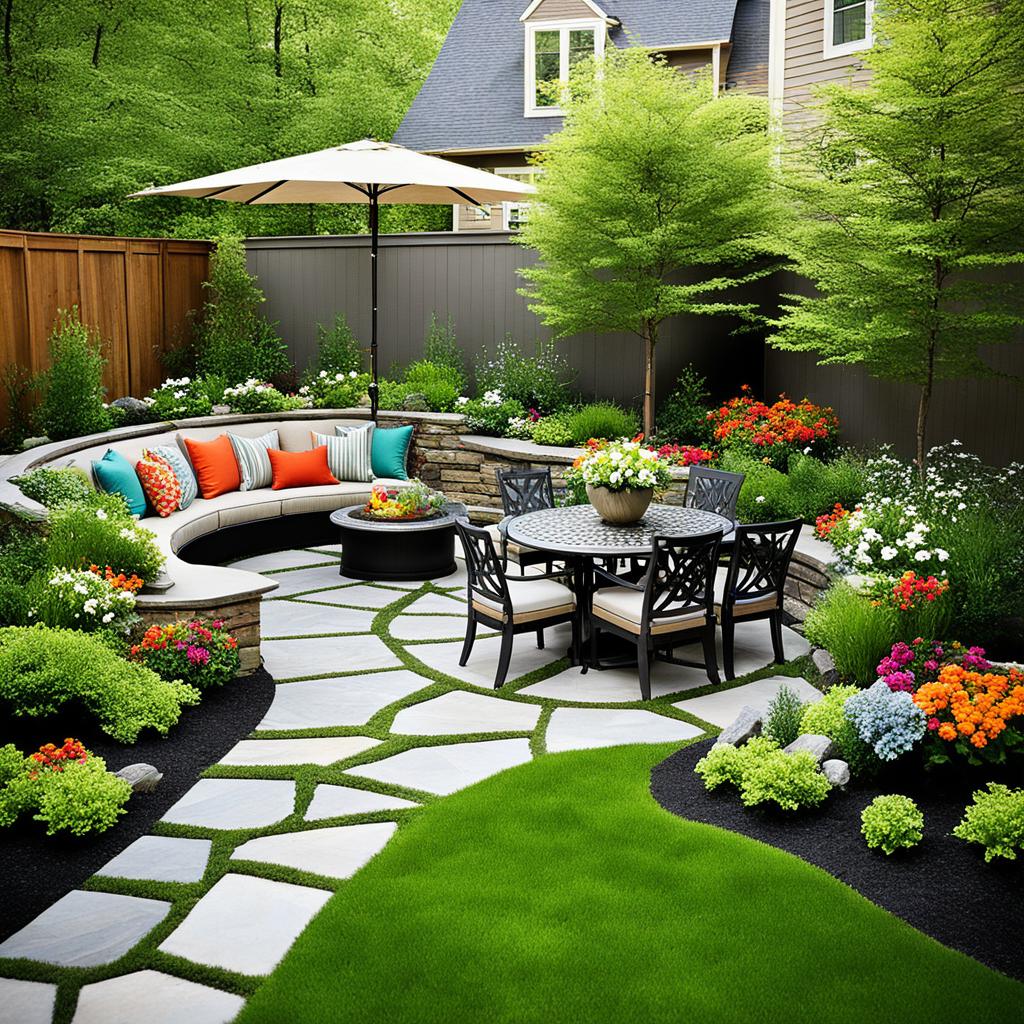
Benefits of Small Front Yard Landscaping
- Enhanced curb appeal and increased property value
- Provides an inviting outdoor living space for relaxation and entertaining
- Efficient use of limited space through vertical gardening and compact design
- Opportunity for creative expression and personalization
- Potential for low-maintenance landscaping with strategic plant selection
Costs of Small Front Yard Landscaping
The cost of this landscaping can change a lot based on the work and items chosen. Let’s look at what things could cost:
| Project Component | Approximate Cost Range |
|---|---|
| Basic landscaping (plants, mulch, edging) | $500 – $1,500 |
| Hardscaping (paths, patios, retaining walls) | $1,000 – $5,000+ |
| Water features (fountains, ponds) | $1,500 – $10,000+ |
| Landscaping services (design, installation) | $500 – $2,000+ |
Even though it could cost a lot upfront, a beautiful front yard adds value to your home. It offers a lovely urban gardening place for you to enjoy over the years.
Compact and Vibrant Container Gardens
Small outdoor areas can feel alive with petite garden layouts. Container gardens are perfect for adding charm with little work, especially in tight spaces. By choosing the right plants, you can turn any small spot into a beautiful garden.
Choosing the Right Planters
Start with picking the right pots for your container garden. You can find terracotta, ceramic, and metal pots that match any style, from old-fashioned to new. This lets your garden blend well with your home’s look.
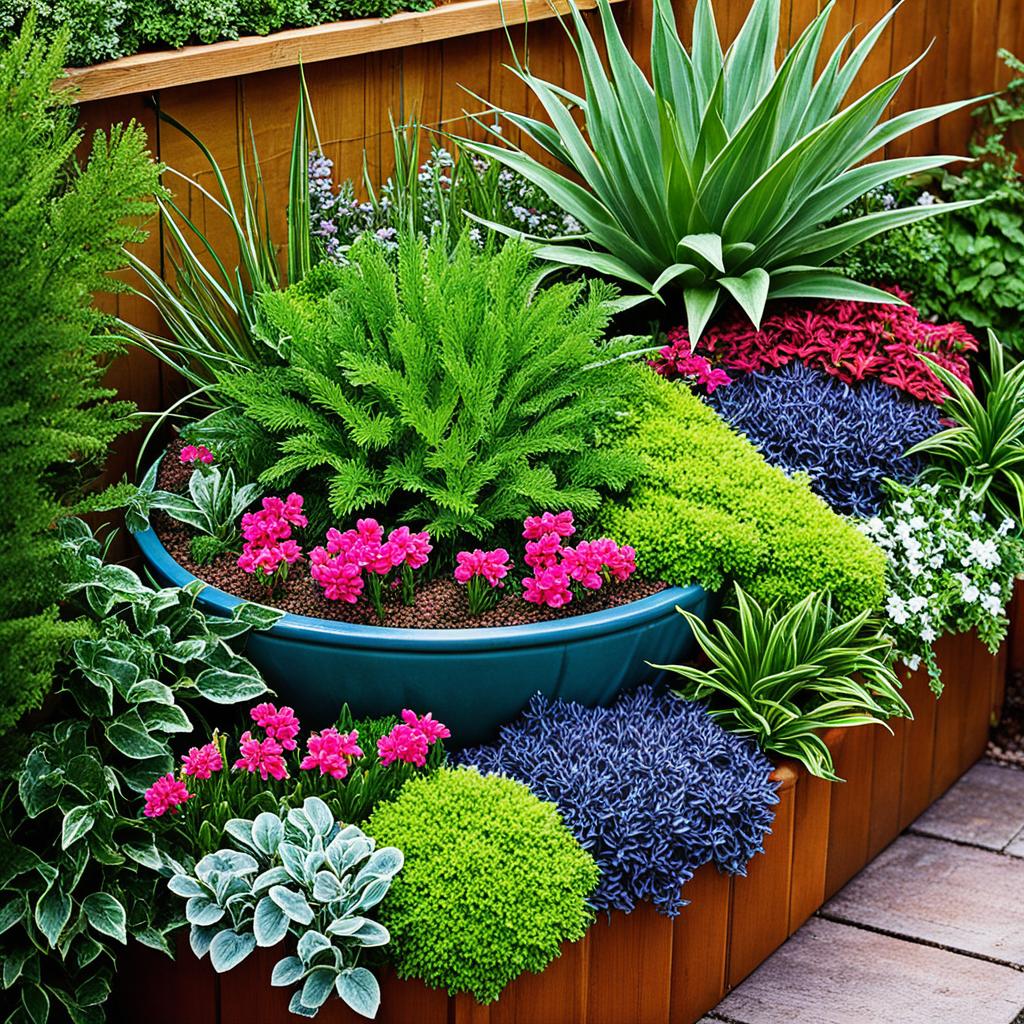
Plant Selection for Containers
Picking the right plants is a key step in small garden design. Choose plants that love the light in your entry area. This includes succulents, bright annuals, and easy perennials for a stunning entrance.
Arrangement and Placement
Group your plants in stylish ways for a beautiful display. Mix up the heights and colors for a more interesting garden. Don’t forget, you can use vertical planters and hanging baskets to save space.
Place pots in key spots to draw the eye, like near doors or along walkways. This can turn your small space into a welcoming green area.
| Plant Type | Sun Exposure | Water Needs | Maintenance |
|---|---|---|---|
| Succulents | Full Sun | Low | Minimal pruning, occasional watering |
| Annuals (Petunias, Marigolds) | Partial Sun | Moderate | Deadheading, regular watering |
| Perennials (Daylilies, Coneflowers) | Full Sun | Moderate | Seasonal pruning, moderate watering |
| Herbs (Rosemary, Thyme) | Full Sun | Low | Occasional pruning, moderate watering |
Gravel and Stone Accents: Versatile Hardscaping Solutions
Gravel and stone accents are great for those who love minimalist yard designs. They offer a simple yet elegant look. These materials are very easy to care for. They can make even a small outdoor area look inviting.
The good thing about using gravel and stone is that they last a long time. They don’t need a lot of maintenance, unlike grass or flowers. This makes them a perfect fit for low-maintenance gardens.
Gravel and stone also come in different styles and colors. This means you can pick what fits your area best. They can be used for paths, borders, or just as decoration.
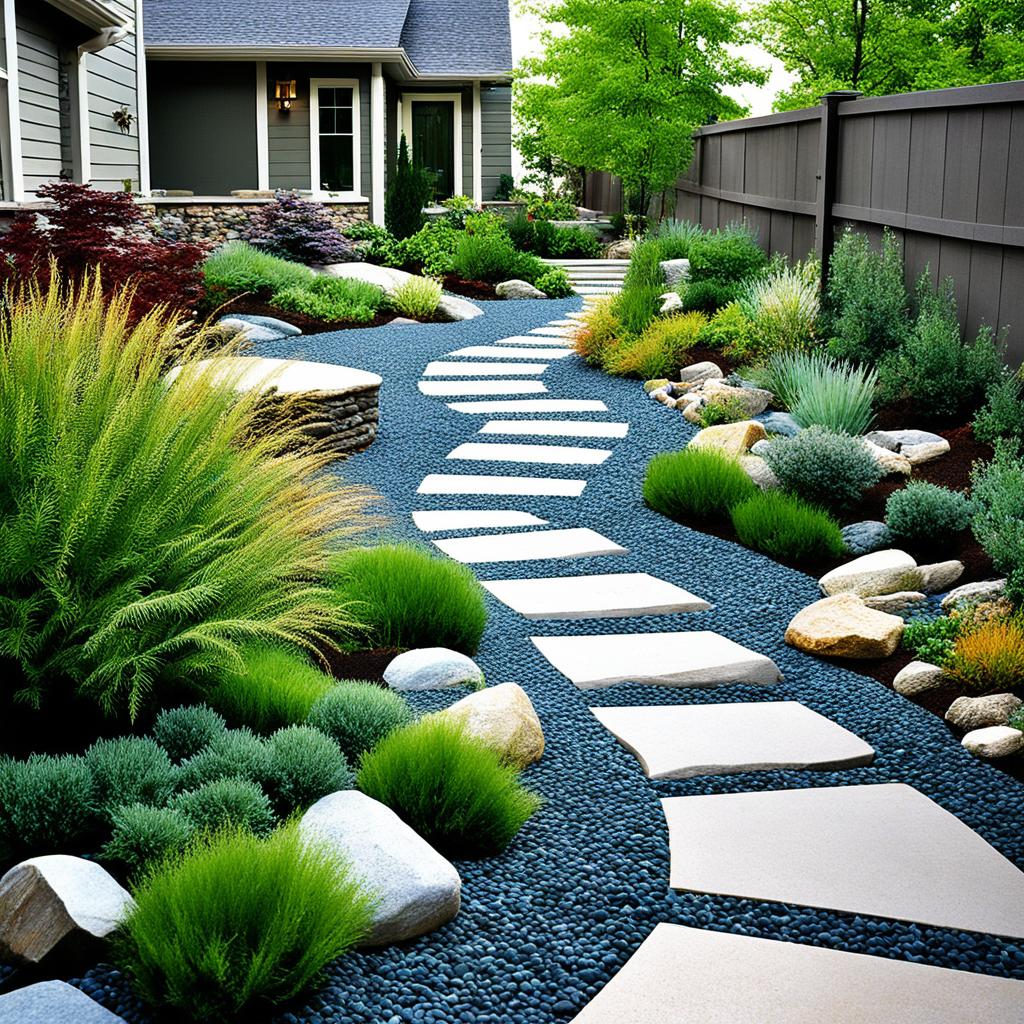
Stone pathways make your home feel welcoming. They also sound nice when you walk on them. It’s a small detail that can make a big difference. Stone borders add a neat finish to your garden beds.
Mulch beds with stone borders can provide a polished and low maintenance look in landscaping projects.
For a bit of flair, mix up different rocks and stones. Using big rocks as features can make your area stand out. It’s a neat way to add interest to a small space.
| Hardscaping Material | Price Range | Difficulty Level |
|---|---|---|
| DIY Kits (gardening, lighting, hardscaping) | $ to $$ | Moderate |
| Upcycled Materials | $ | Easy to Moderate |
| Minimalistic and Modern Landscaping | $$ | Moderate |
No matter your style, gravel and stone can fit right in. They work for a modern look, a country charm, or even a beachy feel. Their strength and beauty make them perfect for both easy-care and small spaces.
Minimalist Greenery Arrangements for Small Spaces
In small front yards, minimalist greenery can make a big impact. It’s a sleek way to create a peaceful outdoor space. By using minimalist design, your patios and entry paths can turn into small, elegant retreats. They will be easy to care for too.
Principles of Minimalist Design
The key to minimalist greenery is keeping things simple. Choose a few plant types with care to bring in different colors and textures. This makes your space look well put together. Plus, it cuts down on the work needed to keep it up.
Low-Maintenance Plant Choices
For a small garden that’s easy to maintain, pick plants that don’t need a lot of attention. Think about using succulents, native plants, or ornamental grasses. These plants use less water and need fewer visits for care. That means you can enjoy your outdoor area more, without a lot of work.
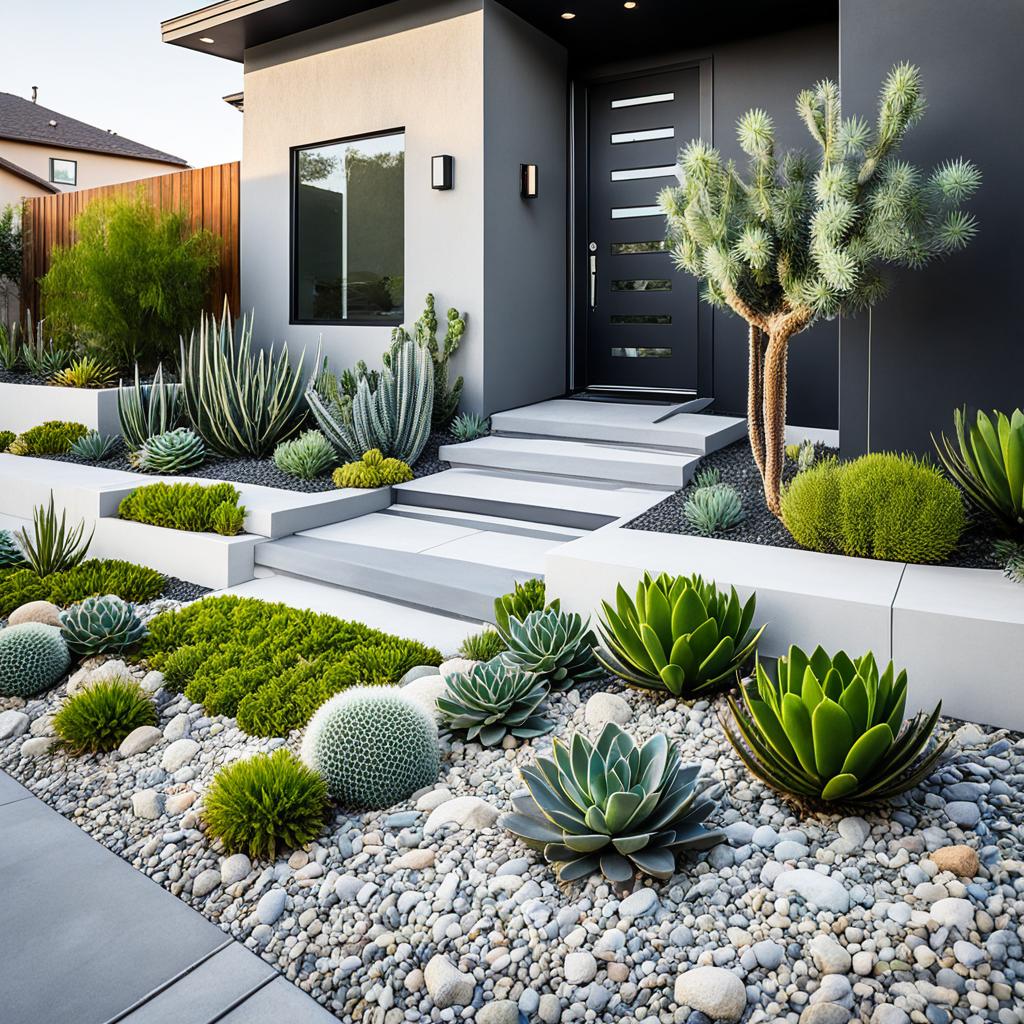
Adding Visual Interest with Textures and Heights
Add in different plants to keep your garden interesting. Use both fine and coarse plants. This adds layers and beauty. Put taller plants or privacy screens to make the garden feel bigger. Low plants on the ground make it welcoming too.
By following these minimalist ideas, your small front yard can be a beautiful, peaceful spot. Its simplicity will be its charm. Let your choice of plants be the star in your cozy outdoor area.
Tiered Planters and Boxes: Maximizing Vertical Space
Having less space in the front yard makes us think creatively. That’s where small space gardening strategies, such as tiered planters and boxes, really shine. They use up high spaces and turn small areas green.
Materials and Styles
There are many types of tiered planters and boxes. You can find them in wood, metal, stone, or concrete. Each material adds its own flair.
Wooden planters feel warm and cozy, while metal ones look sleek. Stone or concrete planters fit well in natural settings. Pick the one that matches your style best.
Planting Techniques for Tiered Structures
Planting in tiers means you should think about plant height and sun needs. Put taller plants in the back for sun and let smaller ones shine. Trailing plants look great in the front, creating a layered look.
Choose plants that go well together. Like pairing bold leaves with soft flowers can look amazing. Using different colors and plants’ textures makes your space pop.
| Tier Level | Plant Types | Examples |
|---|---|---|
| Top | Tall plants, small trees | Dwarf citrus, hibiscus, oleander |
| Middle | Upright shrubs, ornamental grasses | Lavender, rosemary, fountain grass |
| Bottom | Trailing plants, ground covers | Ivy, petunias, sweet potato vines |
Tiered planters and boxes do more than just look good. They hide ugly spots and offer more privacy in your yard. They’re a smart way to upgrade your front yard and make it a green haven.
Symmetrical Plantings and Hedges for Elegant Curb Appeal
Symmetry in your landscaping makes a front yard look both elegant and welcoming. Line your pathways or doorway with neat hedges like boxwood or yew. This step alone can make your front yard look balanced and beautiful.
Adding flower beds designed symmetrically boosts this elegant look. Even small areas can become charming with this approach.
Whether you like the classic English garden or the sleek modern home, symmetry fits any style. It not only makes your space visually pleasing but also helps make the neighborhood look better. In a study, 100% of front yards in Palo Alto with gardens improved the area’s look.
For a polished look, use a variety of plants in your garden. These can include flowering shrubs, small trees, and different perennials. Make sure to choose some for their unique leaves or bark. Plants like Black-eyed Susans and daylilies bring color without needing lots of care.
Spending 20% of your home’s value on landscaping helps keep your home’s resale value high. And, symmetrical plantings are a smart choice to improve your home’s curb appeal.
When it comes to walkways, choose materials that are durable and pretty. This could be poured concrete, brick, stone, or pavers. Make sure your paths are wide so two people can walk comfortably.
Highlight your front door with striking containers or a beautiful sculpture. A colorful door can also make a big difference. These simple changes turn any entryway into a standout.
| Garden Style | Plant Recommendations | Design Elements |
|---|---|---|
| Cottage | Hollies, rhododendrons, bulbs, perennials, colorful annuals | Picket fences, arbors, birdbaths, wildflowers |
| Craftsman Bungalow | Camellias, boxwoods, flowering shrubs, small trees | Water features, herb gardens, benches |
| Contemporary Ranch | Bright foliage, berries, ornamental grasses | Desert plants, colorful plantings, landscape lighting |
| Traditional Colonial | Hollies, boxwoods, flowering trees, perennials | Arbors, benches, sculptural accents |
Small Front Yard: Compact Gardening Techniques
Making the most of a small outdoors area is key. You can use smart gardening tricks to turn even a tiny spot into a beautiful garden. Use methods like vertical gardening solutions, raised beds, and dwarf trees. They are perfect for creating a cottage garden feel or a modern style. Plus, they boost your home’s look from the outside.
Vertical Gardening Solutions
When you’re short on space, think up! Entryway gardens can do amazing. Just use trellises, hanging baskets, and living walls. You can plant vines that climb high. This adds a green, flowing touch. And, hang planters on fences to save space and make your garden interesting. It’s a great way to add layers to your garden design.
Raised Garden Beds
Raised beds are perfect for small area gardening. They give you more planting space by lifting the soil off the ground. You can make them from wood, stone, or even old galvanized tubs. By stacking them or placing at different heights, you create a look that pops. And, they make it easier to keep your plants healthy by improving drainage and soil quality.
Dwarf Trees and Shrubs
Use dwarf trees and shrubs to add structure without taking up too much space. Things like Japanese maples and compact hydrangeas keep your garden interesting all year. Place them well to enhance paths or mark garden corners. This creates a harmonious and ordered appearance.
| Plant | Average Cost | Height (feet) |
|---|---|---|
| Dwarf Japanese Maple | $50 – $200 | 8 – 15 |
| Dwarf Hydrangea | $15 – $50 | 3 – 5 |
| Dwarf Evergreen Shrub | $20 – $80 | 2 – 6 |
These techniques can really make your yard shine. They let you enjoy your gardening hobby fully. Whether you like a cozy cottage garden or a sleek look, these tips will help. They turn your small space into a beautiful garden that uses every inch well.
Pathway and Edging Accents: Defining Your Small Front Yard
Creating zones and guiding movement in a small outdoor area is important. It helps make the space look put together and friendly. Paths and edging not only make things look nicer but also show where your property begins.
Material Options for Pathways
There are many options for pathways that suit different looks and designs. You can use pavers, gravel, or flagstone to give your space a natural feel. Gravel paths are great because they’re easy to take care of and add a touch of the countryside to your home.
Edging Techniques for Visual Interest
Using edging is a small but powerful way to enhance your front yard. It marks the border of your flower beds and improves the look of your pathways. Brick, stone, or wood edging can make your outdoor space feel more complete and beautiful.
Choosing the right materials for these details is key. It connects your yard to your house’s style, making everything flow nicely. This way, your front yard becomes an inviting and coherent part of your home.
| Edging Material | Cost Range | Advantages |
|---|---|---|
| Brick | $710 – $2,200 | Durable, classic look, variety of colors |
| Stone | $710 – $2,200 | Natural appearance, long-lasting, unique character |
| Weathered Wood | $500 – $1,500 | Rustic charm, low-cost option, easy installation |
Leveraging Every Inch in Compact Outdoor Spaces
Don’t let sloped or terraced yards be a challenge. Use smart landscape design to make the most of the space. Adding different levels, like with retaining walls, not only looks good but also gives you more room to plant and relax. You can put in raised garden beds and paths for a beautiful and useful yard.
Multilevel Landscape Design
Turning a slope into a series of levels revolutionizes your yard. It lets you grow easy-care succulent gardens up high, while the bottom levels can have places to sit or displays of potted plants. This design makes the space feel bigger and lets you use even the vertical parts for greenery.
Low-Maintenance Succulent Gardens
Ditch the thirsty grass for easy-to-care-for succulents. These plants come in all sorts of shapes and colors, perfect for a beautiful, low-work garden. Mix them for a rich look, and add rocks for a neat and water-saving style.
Native Plants and Ornamental Grasses
Choose plants that naturally fit your area for less work and a greener space. Go for native species and grasses that need little help to grow well. Use them strategically to make your yard private or to create outdoor rooms, adding more value to your small space.
With clever landscape design and easy-to-care-for plants, you can turn even a tiny front yard into a lovely place. From the way you design paths to how you decorate your porch, good planning makes your small space welcoming and pretty.
| Design Element | Benefits | Considerations |
|---|---|---|
| Retaining Walls | Create distinct levels, increase planting space | Proper drainage, material selection |
| Raised Garden Beds | Vertical gardening, accessibility | Soil quality, irrigation needs |
| Succulent Gardens | Low water usage, drought-tolerant | Drainage, sun exposure |
| Native Plants | Low maintenance, well-adapted | Selecting appropriate species |
| Ornamental Grasses | Texture, privacy screens | Size, growth habits |
Space-Maximizing Garden Features
In a tiny yard design, every inch counts to make a great garden. Raised garden beds and small trees and shrubs are perfect. They turn a small yard into a green paradise.
Raised Garden Beds
Raised garden beds are key for making the most of small spaces. They let you grow more plants up, not out. This design means more plants and easier care. A beautiful garden is possible in a small area without much work.
Dwarf Trees and Shrubs
Dwarf trees and shrubs are great for little yards. They add beauty and depth without taking up too much room. Plants like Japanese maples or dwarf conifers stand out with their small size and interesting leaves. Small shrubs placed well add to the green look without being too much.
Raised beds and small trees and shrubs together make a lovely small garden. They balance use and looks in tiny yards. These space-maximizing garden features help with gardening and make the area look good for the area.
| Garden Feature | Space-Saving Benefits | Aesthetic Appeal |
|---|---|---|
| Raised Garden Beds | Vertical planting space, easy accessibility | Diverse plant varieties, vibrant colors |
| Dwarf Trees | Limited footprint, unique foliage | Focal point, visual interest |
| Dwarf Shrubs | Compact size, border accents | Lush appearance without overcrowding |
Adding a small patio or seating area makes the front yard a great place to relax. It’s the perfect place to enjoy the landscaping you’ve done.
Conclusion
Choosing the right design and plants can turn even a small outdoor area into a stunning oasis. Using vertical gardens and raised beds save space and make your yard look great. Adding pathways also helps. It makes your home look more appealing. By picking plants that are easy to care for and adding nice outdoor decorations, your space becomes welcoming. It flows nicely from the front to the back.
Adding plants that climb, shaped bushes, or colorful container gardens gives your yard its own style. Getting advice from experts like C&L Landscape in Jacksonville, FL, can really help. They know how to get the most out of any size yard. This turns your space into a peaceful place to enjoy, regardless of its size.
Using a simple but smart design, small front yards can still be beautiful. Including unique plants and pathways can create a special place. It draws people in and makes them feel at home. The design can make any guest feel welcome and impressed
